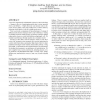Free Online Productivity Tools
i2Speak
i2Symbol
i2OCR
iTex2Img
iWeb2Print
iWeb2Shot
i2Type
iPdf2Split
iPdf2Merge
i2Bopomofo
i2Arabic
i2Style
i2Image
i2PDF
iLatex2Rtf
Sci2ools
SIGCOMM
2006
ACM
2006
ACM
Minimizing churn in distributed systems
A pervasive requirement of distributed systems is to deal with churn — change in the set of participating nodes due to joins, graceful leaves, and failures. A high churn rate can increase costs or decrease service quality. This paper studies how to reduce churn by selecting which subset of a set of available nodes to use. First, we provide a comparison of the performance of a range of different node selection strategies in five real-world traces. Among our findings is that the simple strategy of picking a uniform-random replacement whenever a node fails performs surprisingly well. We explain its performance through analysis in a stochastic model. Second, we show that a class of strategies, which we call “Preference List” strategies, arise commonly as a result of optimizing for a metric other than churn, and produce high churn relative to more randomized strategies under realistic node failure patterns. Using this insight, we demonstrate and explain differences in performance f...
| Added | 14 Jun 2010 |
| Updated | 14 Jun 2010 |
| Type | Conference |
| Year | 2006 |
| Where | SIGCOMM |
| Authors | Brighten Godfrey, Scott Shenker, Ion Stoica |
Comments (0)

